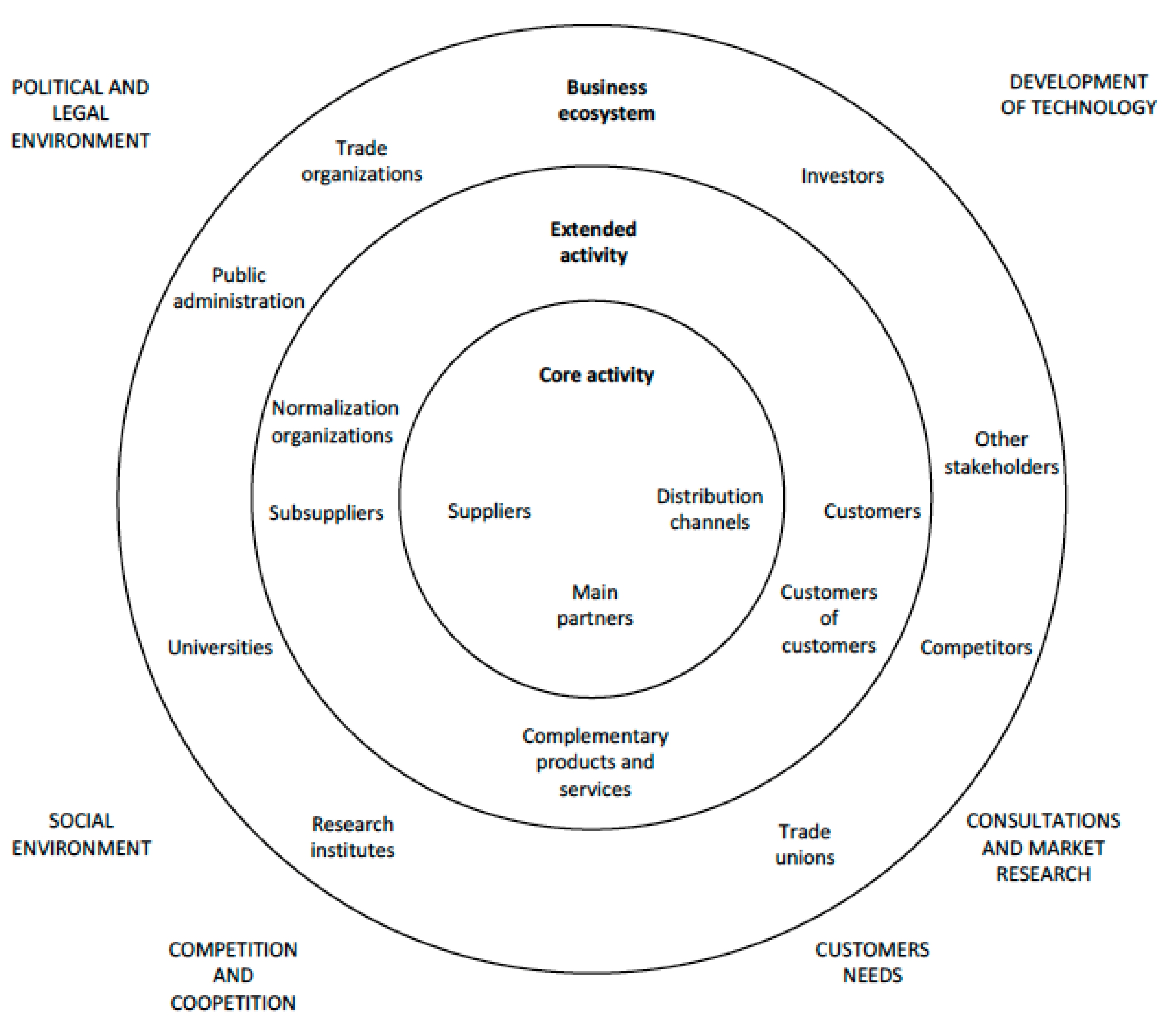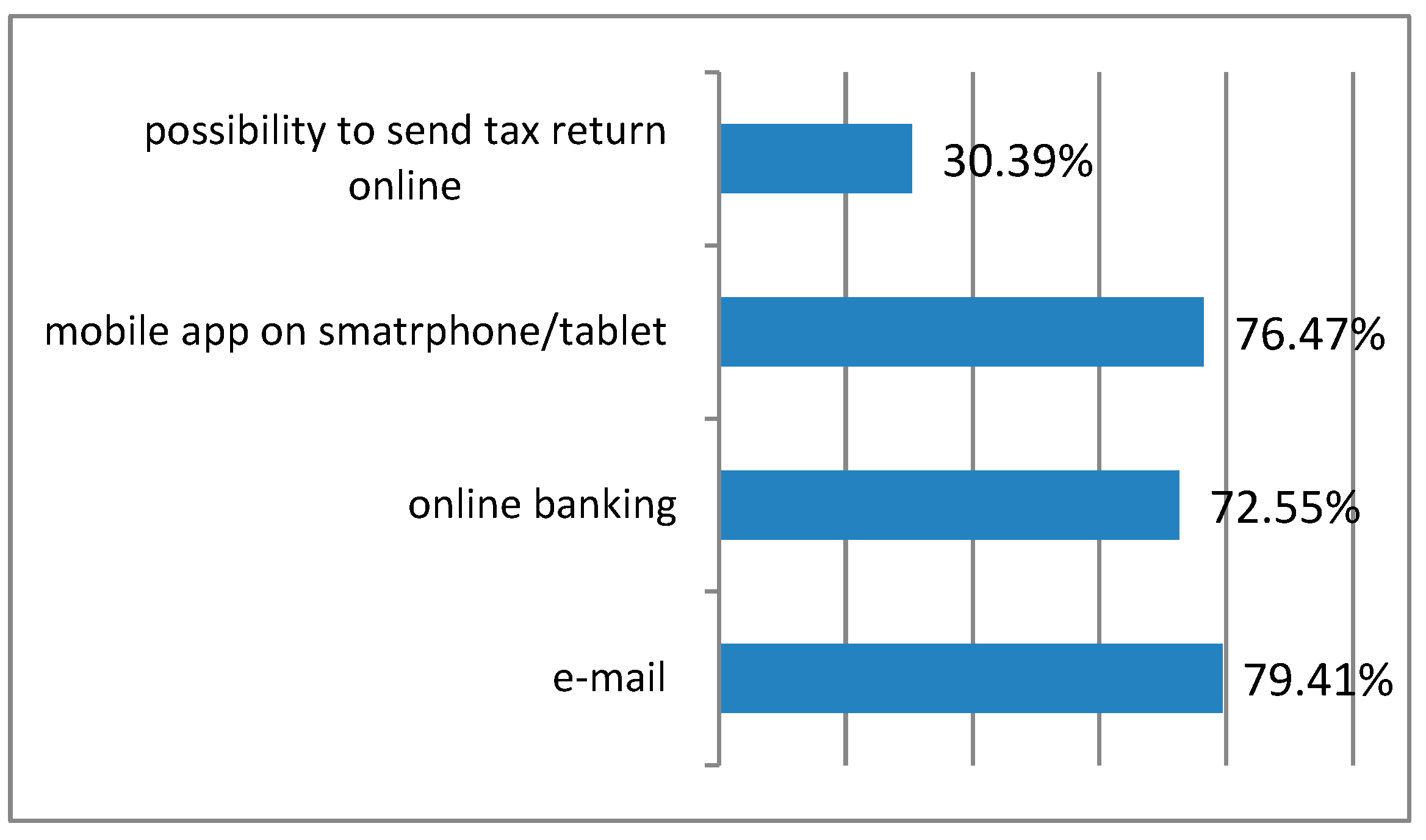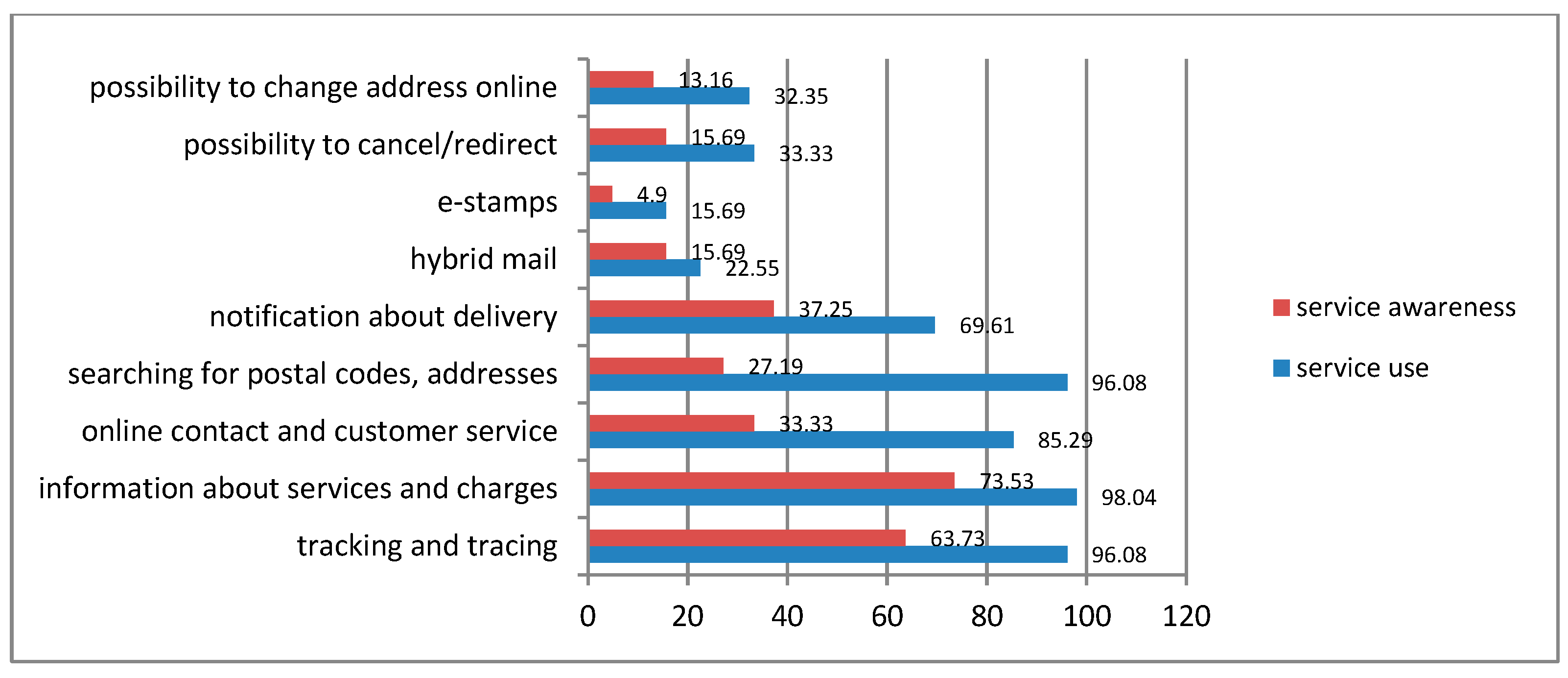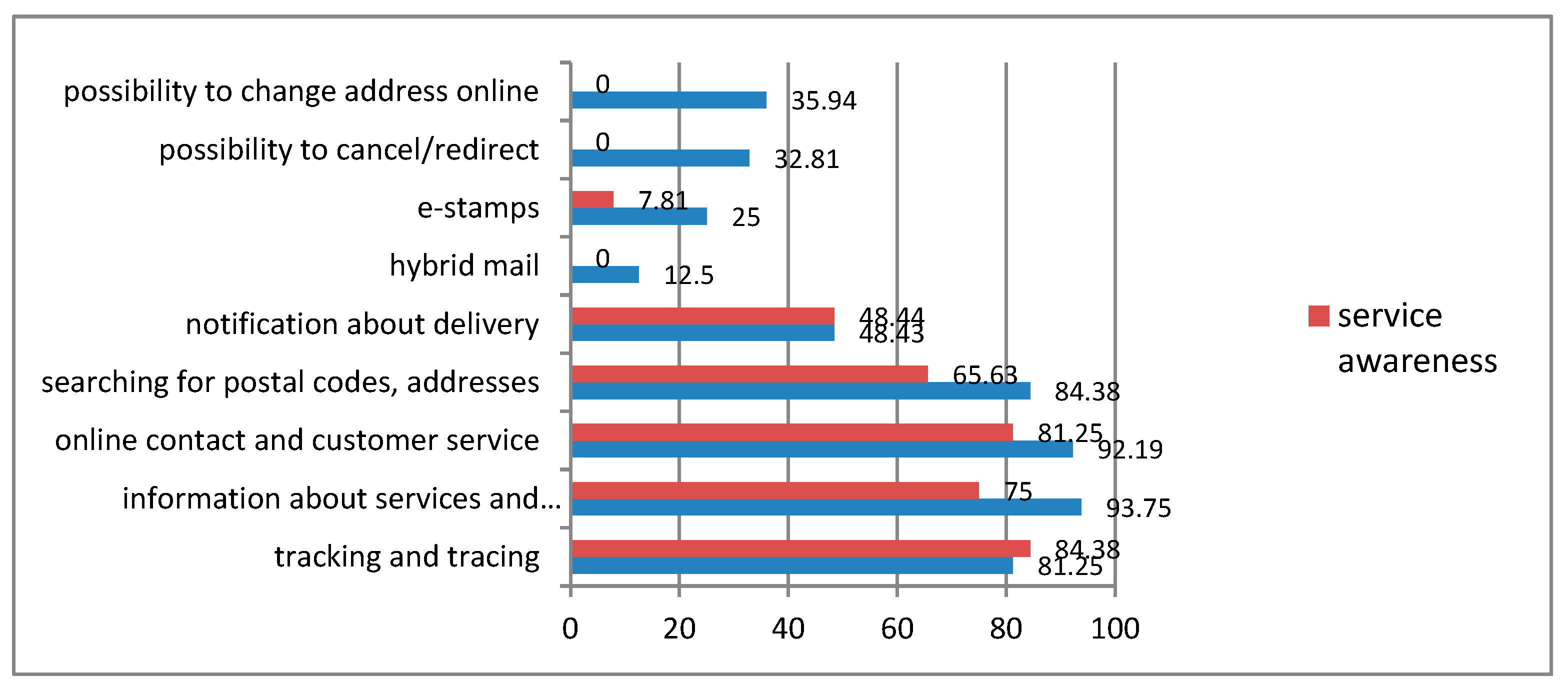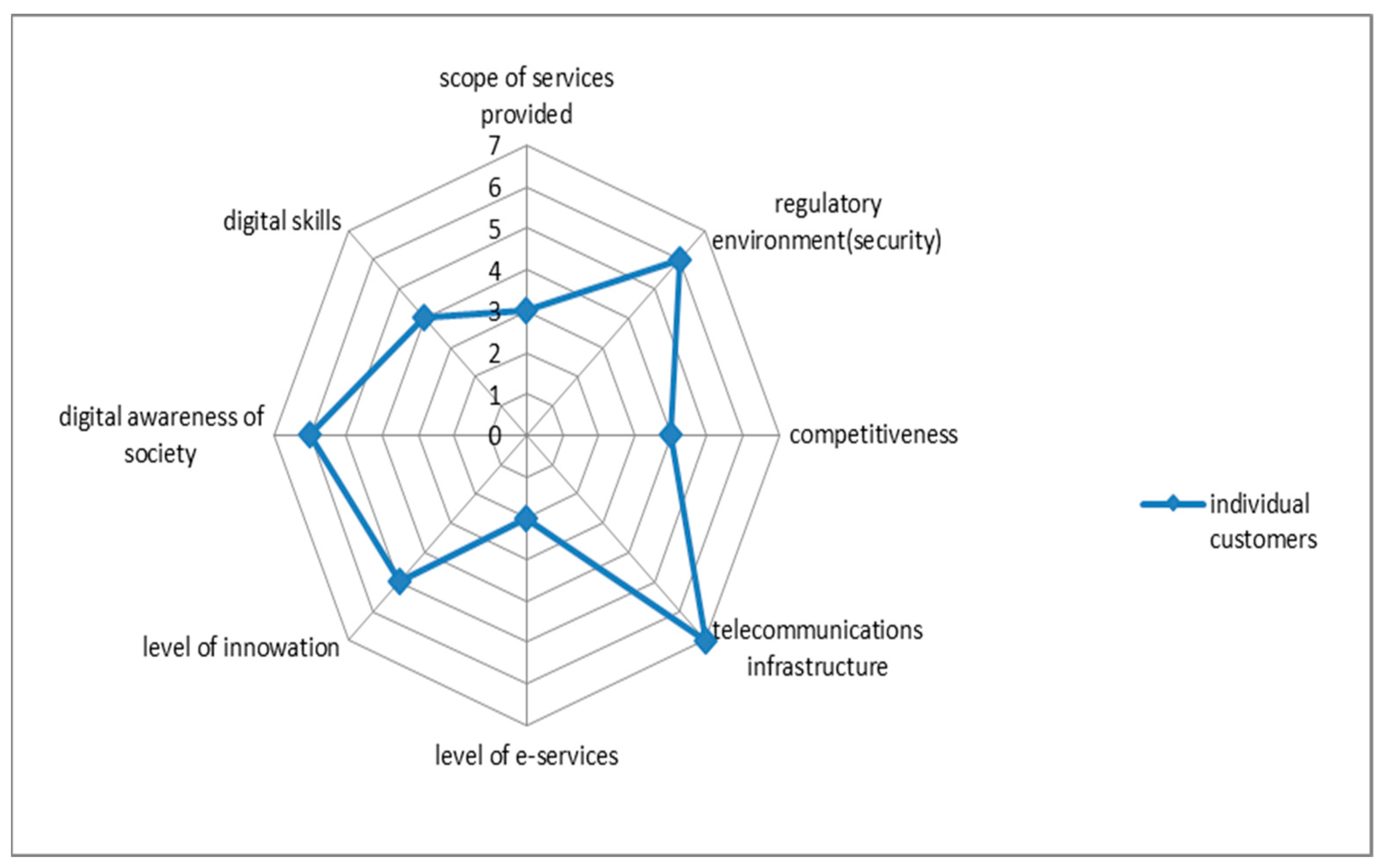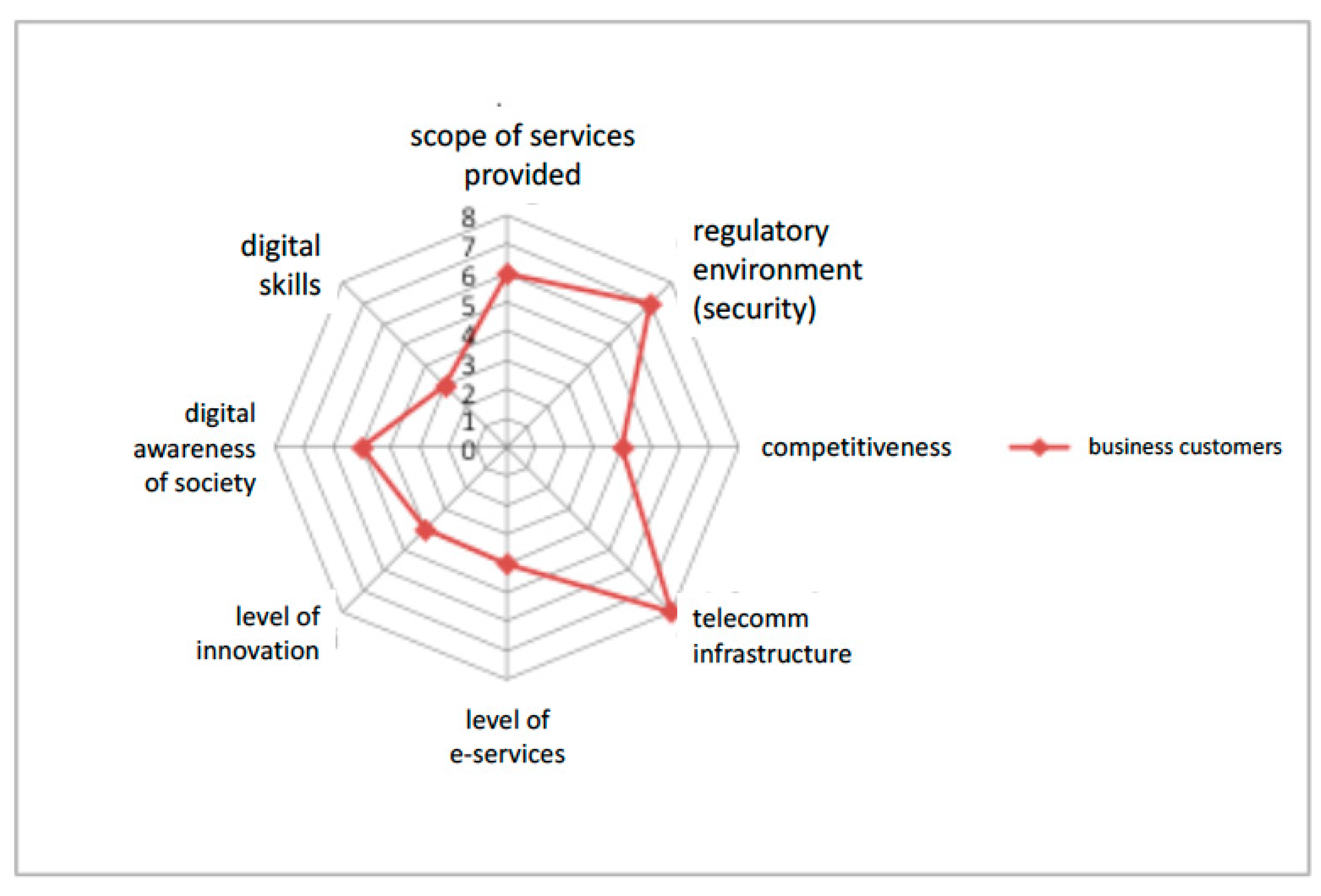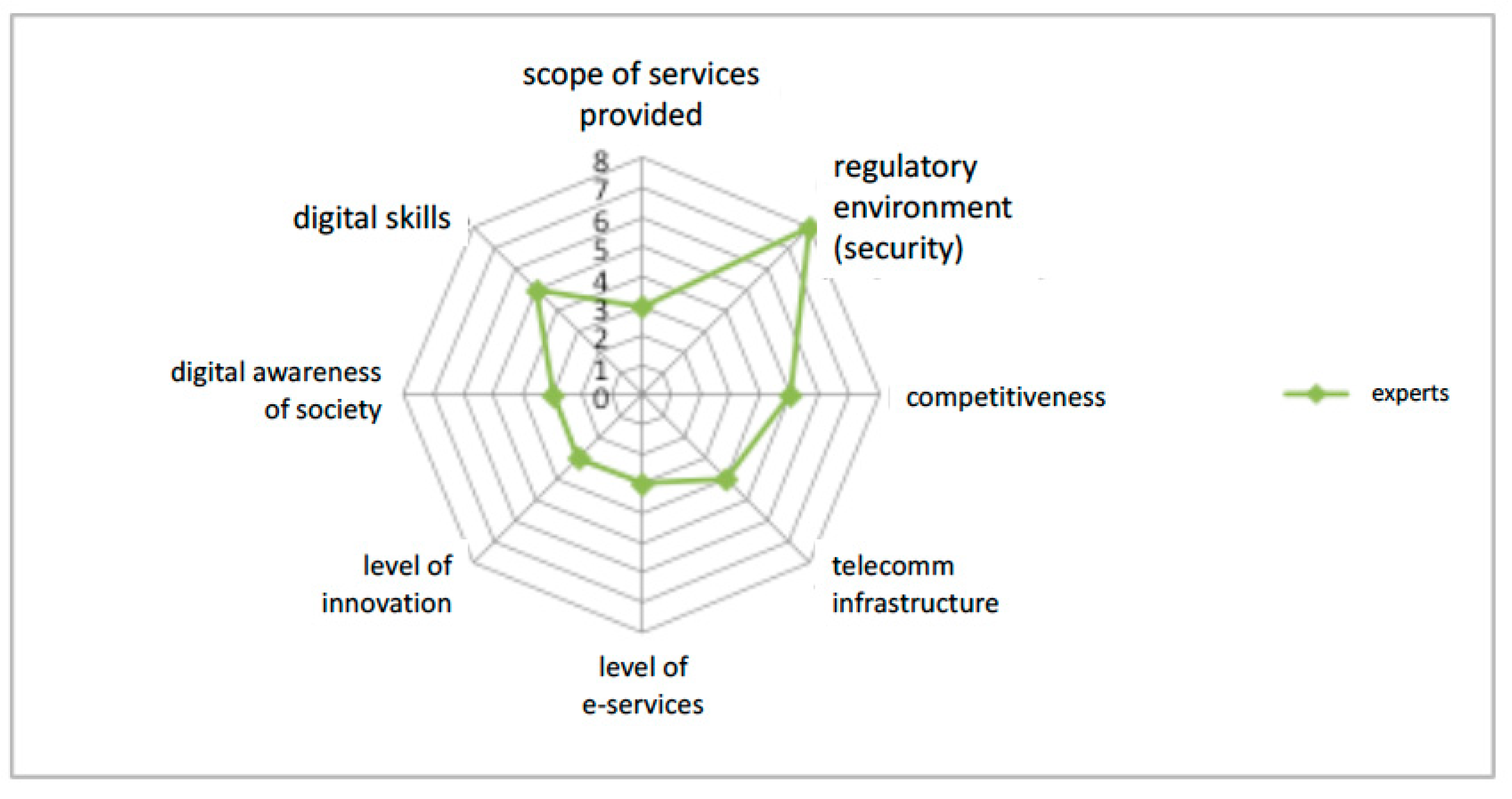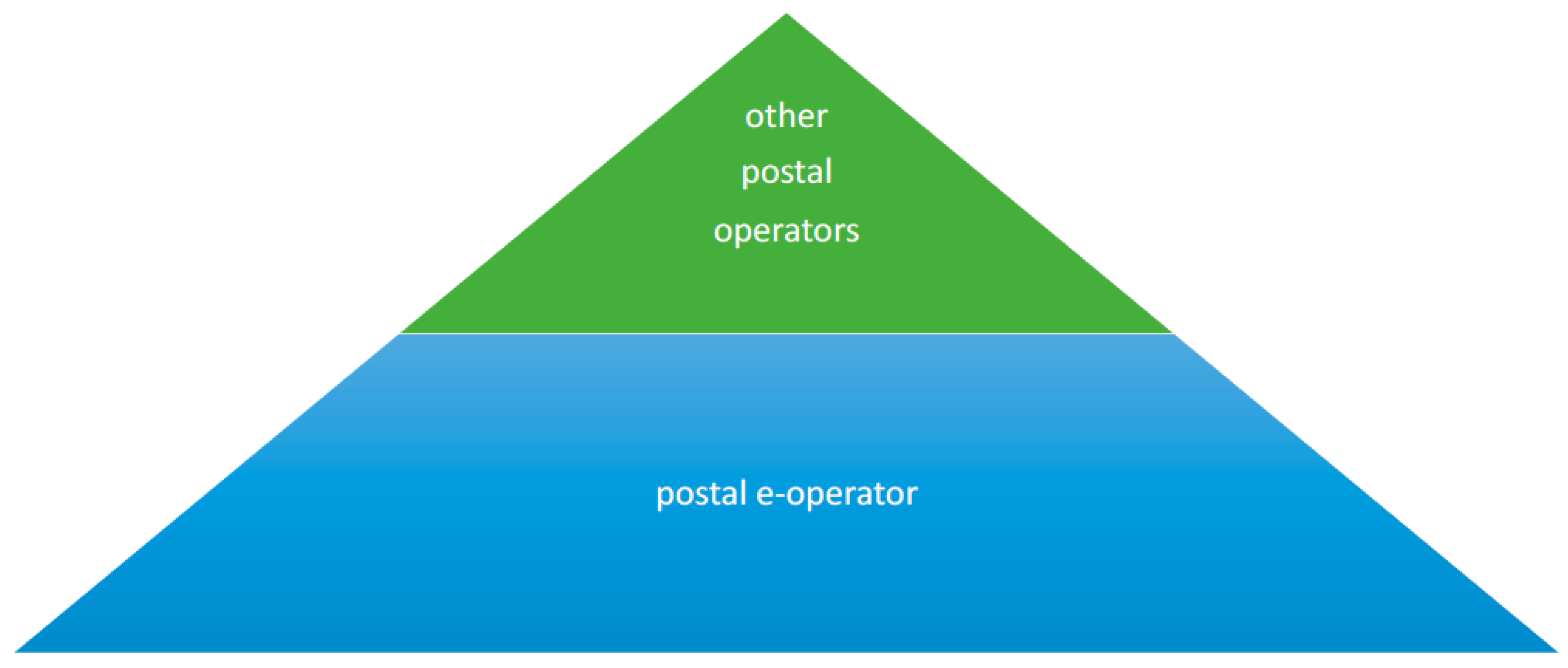2. The Idea of the Business Ecosystem
The notion of ecosystem has been introduced in modern research into social and economic systems in the last decade [
1,
2]. Concepts such as an industrial ecosystem, a digital business ecosystem, an economy as an ecosystem or a social ecosystem have been subjects of many scientific discussions [
3,
4,
5,
6]. The concept of a business ecosystem has developed toward digital ecosystems, innovative service ecosystems etc. Business ecosystem concepts are an extension of the value chain theory [
7,
8]. Apart from elements of the value chain, according to J.F. Moore [
9], who created the concept, the business ecosystem includes other organizations and stakeholders, such as administration, industry institutions and customers, and interactions between them. According to the concept, the performance of business ecosystem organizations depends not only on their own competences but also on interactions with other actors and the condition of the ecosystem [
10,
11,
12].
Figure 1 shows business ecosystem tiers. According to Moore [
9,
13,
14], they correspond to different levels of business activity.
The main tier, corresponding to the core business activity or a network of enterprises, including postal companies, comprises key players and resources needed. In addition to traditional supply chain components, the next tier (expanded activity) includes various actors, such as customers, suppliers and industry standardization bodies. The most external tier of the business ecosystem encompasses research institutions, universities, investors and other stakeholders who, without being directly involved in the core activity, can influence market success [
16]. A similar role is played by external forces, such as competition and co-operation, politics and legal environment, social and technological changes, and research and customer needs.
It should be noted that the literature does not provide a precise and unambiguous definition of the business ecosystem. However, some concepts identify features characteristic for all business ecosystems. Therefore, typical features of the business ecosystem are [
3,
4,
9,
15,
17,
18]:
large number of organizations comprising the ecosystem,
interrelations,
sharing of knowledge (and other resources), interdependence and cooperation between various actors and, at the same time, strong competition (coopetition),
specific roles and positions of ecosystem members, where a change (position) of one element affects the other, multi-directional and complex impacts of external forces (e.g., politics, technologies, markets, human resources, customers etc.) on businesses operating within the ecosystem,
dynamic structure, ability to evolve and develop the entire ecosystem, and
capability to compete with other ecosystems.
According to Wilczyński [
19], the theory of complexity that concentrates on the interaction between elements comprising a single system [
20] is particularly suitable for describing phenomena in a business ecosystem. The business ecosystem supports phenomena typical of a complex adaptive system. These phenomena include emergence, self-organization and coevolution [
19]. In the complexity theory, emergence is linked to the generation of more outputs than the sum of system components [
20]. Emergence is also based on the assumption that a change in one part of the system results in unexpected changes in other parts of the system [
21].
3. A Postal Operator and the Digitalization of the Economy
The modern economy is undergoing major changes, especially regarding modern technologies which determine the development of a digital economy [
22]. The transition to the digital economy is based on the replacement of existing institutions by virtual institutions and direct social relations by social media [
23,
24]. It should be stressed that contemporary businesses that want to survive and compete effectively on the market are forced to innovate and develop modern products and services that meet customer expectations and offer an added value [
25]. The postal industry has also been affected. Being one of the oldest forms of communication, the postal service has kept its unique character in the environment where digital content is transferred instantaneously and in large volumes. At the same time, considering that the postal market is an integral part of economic changes and processes, postal market players should identify and exploit opportunities offered by the rapid development of high-tech electronic communications services. They should also build their position on the digital market by creating a digital postal ecosystem. Key factors in the functioning of the postal market include the changing legal and economic environment, ever growing customer expectations, and aggressive competition due to globalization and convergence. The latter involves fusion of various techniques, networks and market segments.
However, considering that modern electronic communications services complement rather than substitute postal services, electronic communications services, such as e-mail and SMS, are setting new directions for the development of postal operators. While offering these services, they significantly contribute to the development of the e-economy and the economy in general. Another important factor is the link between service segments (parcels, express and courier mail) and the e-commerce market based on the use of information society services. In these areas, postal operators may use online services offered via the Internet [
26]. The multi-faceted perception of innovation drivers involves an interactive relationship between the organization and its environment [
27].
It should be emphasized that modern technologies used by operators enable them not only to process data, but they are also used to provide added value for users in the form of e-products, e-services, and business models.
Consequently, information technologies and digitalization of the economy force postal operators to implement new services, such as hybrid mail. It is important to combine proposed solutions for postal e-services with enhanced efficiency and access to the technology market.
It is commonly believed that postal operators could combine the physical world with the digital one and occupy a strong position on the market while competing with suppliers of digital platforms. Postal operators are frequently seen as public trust institutions. Their advantage is the high accessibility to the post office network. Since postal operators (in particular, designated ones) operate a widespread domestic infrastructure, they enjoy the potential to become partners in providing e-administration services with the use of modern information technologies. This could definitely strengthen the development of the information society. Postal platforms, which provide electronic postal services, can be used to support communication between citizens and authorities.
The process is reflected by the Polish Postal Law as it changed the definition of the ‘postal service’ and extended its scope by the following provision: “postal service includes the transmission of mailings by electronic means, provided they have a physical form of a mailing at the stage of reception, handling or delivery of information” [
28].
The Universal Postal Union (UPU) has also introduced the term ‘e-mail’ to emphasize that new ICT technologies should be used to stimulate the growth of the postal market by enhancing its offer with modern services. Such services can create new potential by adding value to conventional letter and parcel delivery, thereby increasing the efficiency of postal operators and their contribution to the development of the information society [
29,
30,
31,
32,
33]. In addition to traditional services enriched with new elements (e.g., SMS information about mailing), as well as logistics and financial services, an increasing number of postal operators provide their services online. These include advanced e-commerce, e-courier, e-mail, e-publications, designing and distribution of advertisements (including sale of postal addresses), Internet auctions, and physical and non-physical mail integration through dedicated and customer-oriented websites (e.g., e-mail service where customer decides to deliver, archive, print or delete) [
34]. This creates strong direct competition between postal operators and electronic communications companies, a competition which also stimulates their development to meet future challenges.
The analysis of the postal market indicates changes in the number of mailings and selected electronic communications services, as well as revenues from the sale of services in selected segments of the national communications sector. It also shows positive development of the postal market in parallel to the rapid growth of electronic communications services [
35,
36,
37,
38]. Although the postal market does not have a significant impact on the development of the national economy, traditional postal services support continuity of communication.
In order to measure the development of postal e-services, the UPU selected 87 designated operators in UPU member states (The Universal Postal Union surveyed 192 postal operators (members of UPU). The parties surveyed filled out and sent back 45% of questionnaires). E-services considered included those provided directly or on the basis of agreements with third parties through digital channels to individuals, businesses and state administration in a given country. Although the main channel for delivering e-services is the Internet, the analysis also covers mobile phones, tablets, call centers and TV. Four groups of e-services are distinguished [
39]:
electronic mail and e-government,
e-commerce,
electronic financial services and payment solutions, and
electronic support services (auxiliary).
While developing a series of new e-services, the focus was put on digital functionalities, whereas their “physical” aspects (such as delivery or logistics) were excluded. To determine the advancement of electronic postal services provided by designated operators, the Universal Postal Union applied a holistic approach to research. It was based on three basic postal e-service indicators (Postal Electronic Services Index, UPU PES Index) and resulting from them, the Global PES Index. Postal e-services provided by 87 operators are assessed in three areas: their scope (PES 1), external environment (PES 2) and their innovation capacity (PES 3).
Table 1 presents values of individual indicators.
For a given e-service, responses are quantified as follows: yes = 1, no = 0, under development = 0.5. These values are averaged and calculated for each country surveyed. The indicator value shows how many times the standard deviation differs from the mean value. It is also used to compare the distribution at different average values. Then, the indicator value is normalized by the determining of country’s position in the ranking.
PES 1 (scope of e-services) takes into account the evaluation of current e-services provided by designated operators in the selected countries, their strategies applied to the provision of e-services, and their respective categories (e-mail and e-government, e-commerce, digital financial and payment solutions, support/auxiliary services). PES 2 (external environment index) reflects external forces (technological, regulatory and market-competitive environments) that have a direct impact on operators’ ability to enter the digital postal market and taking over its significant share (including entry barriers and key players in this segment). The index is expressed as the aggregated value of the Telecommunications Infrastructure Index (TI Index) and survey data. PES 3 (innovation capacity) reflects the actual development of postal e-services. It combines the level of readiness for digital innovation (human capital, IT infrastructure, financial and organizational effects of digital transformation), strategies applied and the Global Innovation Index. It was assumed that the level of postal e-services in EU countries is reflected by values of individual PES indices presented above.
According to the global PES indicator, Finland is the leader among the 87 UPU countries (also lead position in PES 1 and PES 2). Austria, the Czech Republic and Italy are in the top ten, while Poland is ranked 23rd. It is worth noting the relatively low positions of developed European economies, e.g., Portugal’s highest position (14) regarding the Innovation Index (PES 3). Many of them are below 50. One of the reasons is probably already a high level of development and, therefore, they show a lower potential for innovation growth than less technologically advanced countries. According to the UPU survey, apart from China, forefront positions in the ranking are occupied by Iran, Mauritius and Tunisia. Since 2004, EU countries are ranked from 23 to 47, with Bulgaria 78.
The PES index for Poland is 0.56, which gives Poland the 23rd position among countries surveyed. Its wider analysis shows that there are delays in the implementation of technological solutions, regulations, and market and competition measures.
Among index components, the highest assessment was given to PES 1, which evaluates currently provided e-services by designated operators in selected countries and strategies applied to e-services in general, as well as their specific categories (e-post and e-government, e-commerce, digital financial and payment solutions, support/auxiliary services). The index is 0.55, which translates into the 25th position in the ranking. Poland has a slightly lower position (33) regarding PES 2, with the index value of 0.60. PES 2 takes into account parameters reflecting external forces (technological environment, legal framework and market and completion factors).
According to PES 3, Poland is ranked 36th, with the index level of 0.52. It is unsatisfactory, since it reflects a low level of postal e-services and limited capacity for digital innovation (human resources, IT infrastructure, financial and organizational consequences of digital transformation). Although the development of e-services has moved traditional boundaries in the postal services sector, many operators have been surprised by the scale of the growth [
40]. According to a number of experts and scientists, high-quality postal e-services offer a huge potential for operators which are designated as partners by the state administration to promote the development of e-government services [
41].
In conclusion, it can be pointed out that market experts should focus more on these indices, as their low level can be a symptom of a weaker engagement of postal services in digitalization than in other EU countries and a limited efficiency of domestic economic policy tools that support the development of the information society and e-economy.
4. Research Methodology
4.1. The Survey of Postal E-Services
The CAWI (Computer-Assisted Web Interview) survey implemented in quarter 1 of 2020 covered:
102 Poles above 18 years of age living in the north-west part of Poland,
77 businesses operating in the north-west part of Poland, and
11 experts of the Polish communications market.
The article is based on the following objectives to survey individuals and businesses:
Non-random selection.
Convenience sample.
Predefined sample size.
Statistical significance was set at α= 0.1, whereas the permissible measurement error at d = 0.09.
The largest age group among individual clients includes people of 45–59 (64%). People 60+ accounted for 23%, and the youngest individuals (18–44) accounted for 13%.
As regards to businesses, service and retail companies prevailed, respectively 45% and 39%. Micro and small enterprises accounted for 16% of businesses surveyed, whereas medium-sized enterprises accounted for 75%. The smallest group consisted of large enterprises (9%). Nearly a half of companies (49%) concentrated their business on regional markets, whereas every fourth company offered their services or products not only on the domestic market but also foreign markets.
The survey also included interviews with 11 experts. Telecommunications and postal market experts represented the following institutions: Office of Electronic Communication (UKE), the Polish postal and telecommunications market regulator, Research and Academic Computer Network (NASK), National Institute of Telecommunications, and lead research centers dealing with communications. The snowball method was used to select experts, i.e., experts have provided referrals to recruit other telecommunications experts until the group reached its target size.
The survey evaluated postal e-services provided by the operator in the context of the digital economy. Due to its nature and limited volume, the article further discusses only selected findings. A general goal is to examine expectations, behavior of individual and business customers in the context of postal e-services. Moreover, it was important to examine opinions of postal and telecommunications experts.
4.2. Case Study
The starting point of the analysis is to determine which e-services are most often used. Individual respondents have been asked what kind of postal e-services they use (e-mail, online banking, mobile apps on their smartphones/tablets, online tax return) as shown in
Figure 2.
Among e-services, respondents most often used e-mail (79.41% responses, mainly respondents of 18–44 and 45–59 years of age). Fewer respondents of 45–59 used e-mail, whereas respondents of 18–44 maintained at a steady level. In general, 72.55% of the surveyed declared to use electronic banking. It is important to note that every year, the number of users delivering their tax returns through an online platform has been growing [
42].
Another issue was the awareness and use of postal e-services.
Figure 3 shows the level of knowledge and use of postal e-services among individual customers.
In the individual customers’ group, knowledge of basic postal e-services, such as parcel tracking, service information, customer contact and service, and the bar code search engine appears to be high (above 85%). Other postal e-services, however, are little known (less than 35%). The highest use of e-services has been noted regarding information about postal services and charges (73.53%). Other e-services enjoy much less interest (below 37.25%).
Other reasons for using e-services noted in the survey apply to business customers as shown in
Figure 4.
As with individual customers, businesses show a similar level of knowledge about individual e-services. However, in terms of their use, this group of customers has shown better results. Business customers are more likely to use e-services, such as mail tracking, service information, customer contact and support, and the bar code search engine. The analysis of responses demonstrates that parcel tracking has been implemented at a similar level by all parties surveyed. Among businesses, medium-sized enterprises are the largest group interested in maintaining online contact and providing services to customers. Considering the area of operation, parcel tracking is the most popular among businesses on both domestic and foreign markets. For them, the service is particularly important. As many as 48.44% of business customers use the mail notification service. Business customers also buy e-stamps. Summarizing, business customers are more likely to use e-services. This is mainly due to the ease of information management with the use of modern information technologies and time savings.
The second part of the survey assessed postal e-services offered by the designated operator in Poland. This assessment identified variables that have a significant impact on the perception of postal e-services. These variables are as follows:
scope of e-services provided
legal and regulatory environment (security)
competitiveness
telecommunications infrastructure
level of e-services
level of innovation
digital awareness
digital skills.
The assessment of these variables is based on a scale of 0 to 10, where 0 is very low and 10 is very high. Among individual customers, the telecommunications infrastructure received the highest rating (7). It means that customers believe that there is a technical capacity for the provision of postal e-services. Next was digital awareness (6) which could be defined as the understanding of the need to develop digital competences. The same assessment was given to the level of the regulatory framework, especially in the context of security. It means that individual customers are aware of legal security measures applied. However, the lowest rating by individual customers was given to the level of e-services provided by the postal operator. For customer feedback, see
Figure 5.
As in the case of individual customers, businesses gave their highest rating to the telecommunications infrastructure (8). It means that businesses believe that there is a technical capacity to provide postal e-services. Slightly lower (7) was the assessment of the legal and regulatory environment. The range of e-services provided by the postal operator was assessed slightly above the average (6). Digital awareness of the society was rated 5 by the surveyed. Business customers surveyed assigned the lowest rating to digital skills. This has been based on the direct observation of customers. For the opinion of business customers, see
Figure 6.
Particularly interesting is the opinion of postal market experts, as shown in
Figure 7. In comparison with individual and business customers, their assessment of the services was lower.
Only the legal and regulatory environment received the highest assessment. According to experts, legal regulations determine the secure provision of e-services. Variables, such as competitiveness and digital skills, have been assessed at an average level (5). Elements, such as the scope of the services provided, their advancement, and the digital awareness among the public are assessed at level 3.
5. Discussion
5.1. Main Problems
The discussion in the article shows that the knowledge of practical application of postal e-services is an important and difficult issue from the point of view of the digital post ecosystem development. The analysis of EU postal markets, including the Polish market, has shown that the trend is to substitute traditional dedicated documents with online solutions. It should be emphasized that the new environment supports all advantages of traditional postal services, including mailings, financial transactions and insurance, and provides an opportunity to select location, accessibility, and time during and after the transaction. With the rapid growth of e-commerce, the digital ecosystem has become an increasingly important area of postal services. Summarizing, to be competitive, postal operators need to digitalize traditional postal services. By doing so, they can secure their position on the market. As mentioned previously, the goal of the article is to offer a proposal for a designated operator to create a digital postal ecosystem.
Research findings shown above are based on scientific research. This helped to develop activities aimed to digitalize the incumbent operator and thus to present the Post 4.0 model.
It should be noted that recently in EU member states, the commitment to modern technologies promoting digitalization of postal services has increased tremendously. These technologies enable to provide modern services which are an added value to traditional postal services. The analysis of foreign postal markets [
43] has shown that, in addition to post and parcel delivery services, operators have been expanding by adding new services (e.g., SMS notification). Apart from traditional logistics and financial services, operators increasingly often provide online services.
Further development of Polish and European postal service markets should proceed toward e-government services. Examples in the EU show that these services can be used by national governments to exchange correspondence and documents with citizens and to expedite communication. They constitute a major improvement for citizens. Additionally, such services enable to store official correspondence on a designated platform. It should be stressed that today, when virtual exchange of correspondence has been growing, a modern state should adapt its potential to the trend and provide citizens with an efficient digital service. It should be noted that modern technologies ensure a high level of security for the communication between the state and citizens. However, people without relevant competences or the ability to receive digital correspondence from public authorities may be exempted from this form of communication and use the traditional postal service.
Moreover, several postal operators have already used this opportunity, whereas others are still getting ready for it. More importantly, apart from the development of personalized services in the digital space, postal operators need to cooperate with their governments, while concentrating on their social environment. This is particularly important since the society is not prepared to utilize digital postal services in full. Summarizing, it is necessary to implement measures designed to establish the digital e-post ecosystem.
5.2. Proposed Operation of the Digital E-Post Ecosystem
The digitalization of the economy and society is one of the most rapid transformations of our times. While it opens new opportunities for postal operators, it brings uncertainty and various threats, e.g., social consequences of production automation and broadly understood security. The nature of these revolutionary changes is of particular importance, since it translates into completely new values for parties operating on the market and consumers. To meet these challenges, individual companies, public administration, society and national economies need to undergo digital transformation. Traditional mailings form a crucial area for postal operators. However, the digitalization of the economy poses a major risk of reducing the volume of regular mailings, especially in developed countries. The trend is directly linked with e-substitution of traditional postal services. On the one hand, it is the most threatened area, and on the other hand, it offers tremendous opportunities, provided a new concept for services is implemented. The new concept should enable to replace the handling of traditional mailings with modern information technologies while maintaining the previous role of postal operators.
The provision of digital services requires state approval, appropriate economic policy tools and major investment in modern technologies and infrastructure.
Figure 8 shows actions leading to the digitalization of the incumbent operator.
This option enables to counteract digital exclusion [
44] by promoting universal access. The activity of postal operators in the area of e-services may lead to the strengthening of their position on the postal market [
45].
Figure 9 shows the Post 4.0 model for the postal services market.
Post 4.0 is an action proposal where economic regulations are the most important. This action proposal should take into account capital-intensive investment in modern technologies and IT systems as pillars for shifting the activity of postal operators to the virtual space. Although administrative and institutional regulations are less developed, coordination in this area is necessary, especially in the context of the development of e-services. Particular emphasis should be put on e-government and the engagement of the state administration in the process at local, regional and national levels. Moreover, awareness building and intensive IT education should focus on public e-services. Administrative regulations may help the government to create a possibility to use the incumbent operator’s platform.
